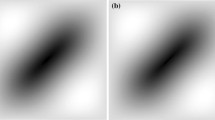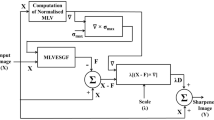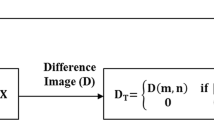Abstract
Magnetic Resonance Imaging (MRI) is a powerful imaging modality with highly specific applications in medicine. However, certain series and sequences of MRI do not produce images with good acuity. Widely-used sharpening algorithms like Shock Filter (SF) and Unsharp Masking (UM) do not provide output images with appreciable sharpness-to-noise ratio. Output images of UM are prone to discontinuity artefact. A noise-robust sharpening algorithm to enhance acuity of MR images termed as Nonlinear Amplification of Spatial Derivative (NASD) that does not have the issue of discontinuity artefact is introduced in this paper. In the NASD, the enhanced image is estimated from the amplified spatial derivative in an inverse way. To avoid the amplification of noise, the amplification factor at any pixel location is calculated from a nonlinear function of the mean of the absolute values of the gradients along eight different orientations at that location. On hundred test images, the sharpness-to-noise ratio exhibited by NASD, SF and UM are 0.0963 ± 0.0400, 0.1642 ± 0.0967 and 0.2851 ± 0.1610. The computation time (in seconds) of NASD, SF and UM are 0.0330 ± 0.0031, 0.0452 ± 0.0390 and 0.0554 ± 0.0112. The NASD exhibits higher values of sharpness-to-noise ratio than SF and UM. NASD is able to sharpen the edges in the input image without amplifying noise and it is computationally fast like SF and UM.












Similar content being viewed by others
Availability of data and material
Data may be provided on request.
Code availability
Code can be made available on request.
References
Aysal TC, Barner KE (2006) Quadratic weighted median filters for edge enhancement of noisy images. IEEE Trans Image Process 15(11):3294–3310
Bai Y, Jia H, Jiang M, Liu X, Xie X, Gao W (2020) Single image blind deblurring using multi-scale latent structure prior. IEEE Trans Circ Syst Video Technol 30(7):2033–2045
Bhateja V, Misra M, Urooj S (2017) Human visual system based unsharp masking for enhancement of mammographic images. J Comput Sci 21:387–393
Bhateja V, Misra M, Urooj S (2018) Unsharp masking approaches for HVS based enhancement of mammographic masses: a comparative evaluation. Future Gener Comput Syst 82:176–189
Bhateja V, Nigam M, Bhadauria AS, Arya A, Zhang EY (2019) Human visual system based optimized mathematical morphology approach for enhancement of brain MR images. J Ambient Intell Human Comput. https://doi.org/10.1007/s12652-019-01386-z
Cherukuri V, Guo T, Schiff SJ, Monga V (2020) Deep MR brain image super-resolution using spatio-structural priors. IEEE Trans Image Process 29:1368–1383
Coupé P, Yger P, Prima S, Hellier P, Kervrann C, Barillot C (2008) An optimized blockwise nonlocal means denoising filter for 3-D magnetic resonance images. IEEE Trans Med Imaging 27(4):425–441
Guo J, He C, Wang Y (2020) Fourth order indirect diffusion coupled with shock filter and source for text binarization. Sig Procg 171:107478
Hardie RC, Boncelet CG (1995) Gradient-based edge detection using nonlinear edge enhancing prefilters. IEEE Trans Image Process 4(11):1572–1577
Ho KC, Speier W, Zhang H, Scalzo F, El-Saden S, Arnold CW (2019) A machine learning approach for classifying ischemic stroke onset time from imaging. IEEE Trans Med Imaging 38(7):1666–1676
Ibrahim H, Kong NS (2009) Image sharpening using sub-regions histogram equalization. IEEE Trans Consum Electron 55(2):891–895
Jeon G (2017) Computational intelligence approach for medical images by suppressing noise. J Ambient Intell Human Comput. https://doi.org/10.1007/s12652-017-0627-9
Jiao Z, Ji Y, Gao P, Wang SH (2020) Extraction and analysis of brain functional statuses for early mild cognitive impairment using variational auto-encoder. J Ambient Intell Human Comput. https://doi.org/10.1007/s12652-020-02031-w
Joseph J, Anoop BN, Williams J (2019) A modified unsharp masking with adaptive threshold and objectively defined amount based on saturation constraints. Multimed Tools Appl 78:11073–11089
Jung CR, Scharcanski J (2009) Sharpening dermatological color images in the wavelet domain. IEEE J Sel Top Sig Process 3(1):4–13
Krasula L, Callet PL, Fliegel K, Klíma M (2017) Quality assessment of sharpened images: challenges, methodology, and objective metrics. IEEE Trans Image Process 26(3):1496–1508
Lian C, Liu M, Zhang J, Shen D (2020) Hierarchical fully convolutional network for joint atrophy localization and alzheimer’s disease diagnosis using structural MRI. IEEE Trans Pattern Anal Mach Intell 42(4):880–893
Liu X, Tanaka M, Okutomi M (2013) Single-image noise level estimation for blind denoising. IEEE Trans Image Process 22(12):5226–5237
Liu S, Zhao C, Liu M, Xin Q, Wang SH (2019) Diffusion tensor imaging denoising based on Riemann nonlocal similarity. J Ambient Intell Human Comput 19:1–4
Lyu Q, Shan H, Wang G (2020) MRI super-resolution with ensemble learning and complementary priors. IEEE Trans Comput Imaging 6:615–624
Narmatha C, Eljack SM, Tuka AA, Manimurugan S, Mustafa M (2020) A hybrid fuzzy brain-storm optimization algorithm for the classification of brain tumor MRI images. J Ambient Intell Human Comput 14:1–9
Osher S, Rudin LI (1990) Feature-oriented image enhancement using shock filters. SIAM J Numer Anal 27(4):919–940
Paul J, Sivarani TS (2020) Computer aided diagnosis of brain tumor using novel classification techniques. J Ambient Intell Human Comput. https://doi.org/10.1007/s12652-020-02429-6
Rajan J, Poot D, Juntu J, Sijbers J (2010) Noise measurement from magnitude MRI using local estimates of variance and skewness. Phys Med Biol 55(16):N441
Rundo L, Tangherloni A, Nobile MS, Militello C, Besozzi D, Mauri G, Cazzaniga P (2019) MedGA: a novel evolutionary method for image enhancement in medical imaging systems. Expert Syst Appl 119:387–399
Schavemaker JG, Reinders MJ, Gerbrands JJ, Backer E (2000) Image sharpening by morphological filtering. Pattern Recognit 33(6):997–1012
Simi VR, Edla DR, Joseph J, Kuppili V (2019) Analysis of controversies in the formulation and evaluation of restoration algorithms for MR Images. Expert Syst Appl 135:39–59
Simi VR, Edla DR, Joseph J, Kuppili V (2020) Parameter-free fuzzy histogram equalisation with illumination preserving characteristics dedicated for contrast enhancement of magnetic resonance images. Appl Soft Comput 5:106364
Torrents-Barrena J, Piella G, Masoller N, Gratacós E, Eixarch E, Ceresa M, Ballester MÁ (2019) Fully automatic 3D reconstruction of the placenta and its peripheral vasculature in intrauterine fetal MRI. Med Image Anal 54:263–279
Umer S, Rout RK, Pero C (2021) Facial expression recognition with trade-offs between data augmentation and deep learning features. J Ambient Intell Human Comput. https://doi.org/10.1007/s12652-020-02845-8
Vu CT, Phan TD, Chandler DM (2011) S3: a spectral and spatial measure of local perceived sharpness in natural images. IEEE Trans Image Process 21(3):934–945
Xiao J, Pang G, Zhang Y, Kuang Y, Yan Y, Wang Y (2016) Adaptive shock filter for image super-resolution and enhancement. J vis Commun Image Represent 40:168–177
Yu L, Zhang D, Peng N (2021) Research on the application of binary-like coding and Hough circle detection technology in PCB traceability system. J Ambient Intell Human Comput. https://doi.org/10.1007/s12652-020-02655-y
Zhang B, Allebach JP (2008) Adaptive bilateral filter for sharpness enhancement and noise removal. IEEE Trans Image Process 17(5):664–678
Zhu X, Milanfar P (2010) Automatic parameter selection for denoising algorithms using a no-reference measure of image content. IEEE Trans Image Process 19(12):3116–3132
Funding
This study received no funding.
Author information
Authors and Affiliations
Corresponding author
Ethics declarations
Conflict of interest
The authors declare that they have no conflict of interest.
Human and animal rights
This article does not contain any studies with human participants or animals performed by any of the authors.
Additional information
Publisher's Note
Springer Nature remains neutral with regard to jurisdictional claims in published maps and institutional affiliations.
Rights and permissions
About this article
Cite this article
Simi, V.R., Edla, D.R. & Joseph, J. An inverse mathematical technique for improving the sharpness of magnetic resonance images. J Ambient Intell Human Comput 14, 2061–2075 (2023). https://doi.org/10.1007/s12652-021-03416-1
Received:
Accepted:
Published:
Issue Date:
DOI: https://doi.org/10.1007/s12652-021-03416-1




